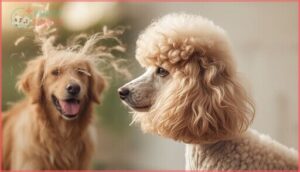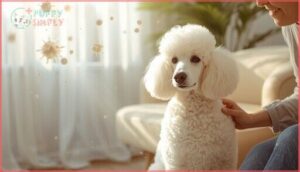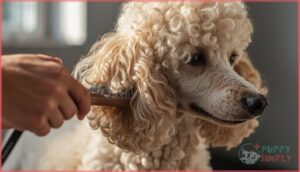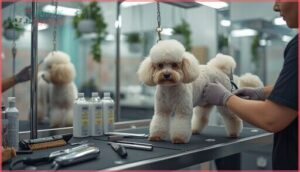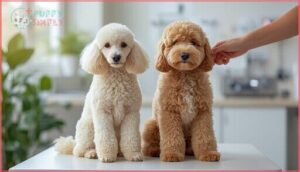This site is supported by our readers. We may earn a commission, at no cost to you, if you purchase through links.
Most dog breeds shed according to a predictable seasonal pattern, losing their undercoat as temperatures shift. Poodles break that rule entirely. Their unique coat biology means they shed only 5-10% of their hair annually through a continuous 21-day rotation, with virtually no seasonal variation.
This single-layer coat traps loose hairs within those signature curls rather than releasing them onto your furniture, which explains why Poodles have earned their reputation as a low-shedding breed.
But low-shedding doesn’t mean no-maintenance, and it definitely doesn’t guarantee you won’t sneeze around them. Understanding how Poodle coats actually work helps you manage grooming needs and set realistic expectations about allergies.
Table Of Contents
- Key Takeaways
- Do Poodles Shed?
- Why Do Poodles Shed So Little?
- Are Poodles Hypoallergenic?
- Managing Poodle Shedding
- Diet, Health, and Shedding in Poodles
- Poodles, Doodles, and Shedding Differences
- Frequently Asked Questions (FAQs)
- Do Poodles shed the same color?
- When do Poodles lose their coat?
- Do Poodles shed a lot?
- Why is my poodle shedding so much?
- Do Poodles lose hair?
- Do poodles have a shedding gene?
- Can seasonal changes affect poodle shedding patterns?
- Do poodles shed more when theyre stressed?
- What age do poodles start shedding normally?
- How does climate impact poodle coat maintenance?
- Conclusion
Key Takeaways
- Poodles shed only 5-10% of their coat annually through a continuous 21-day cycle, with their single-layer curly coat trapping loose hairs until brushing rather than releasing them around your home like double-coated breeds do.
- Despite being labeled “hypoallergenic,” Poodles still produce the same allergen proteins (primarily Can f 1) as other breeds—their curls simply trap dander close to the skin instead of spreading it, which helps but doesn’t eliminate allergic reactions.
- Daily brushing and professional grooming every 4-8 weeks aren’t optional maintenance tasks—they’re biological necessities because trapped hairs will mat without removal, and coat health directly reflects nutritional status and underlying health conditions.
- Poodle mixes (Doodles) inherit unpredictable shedding patterns that can range from minimal to moderate depending on which parent’s genetics dominate, making purebred Poodles the more reliable choice for consistent low-shedding characteristics.
Do Poodles Shed?
If you’re considering a Poodle or already have one, you’ve probably heard they don’t shed much—but what does that really mean? The truth is, Poodles do shed, just not in the way most dogs do.
Let’s break down how often Poodles shed, what makes their coat different from typical dog fur, and whether shedding varies between Toy, Miniature, and Standard Poodles.
Shedding Frequency in Poodles
Unlike breeds that leave hair all over your furniture, your Poodle operates on a remarkably tidy shedding cycle—releasing just 5–10% of their coat annually through a roughly 21-day rotation. Those curly locks trap most loose hairs until you brush them out, which explains why you won’t find tumbleweeds rolling across your floors.
Poodles shed just 5–10% of their coat annually, and their curly locks trap loose hairs until you brush them out
Seasonal variations? Practically nonexistent compared to double-coated breeds. Understanding the poodle’s shedding patterns can further improve your grooming practices.
Hair Vs. Fur in Poodles
That “hair versus fur” distinction you’ve heard isn’t just semantics—it’s biology. Your Poodle’s coat grows continuously for months through an extended anagen phase, much like human hair, while typical fur breeds cycle through shorter growth spurts.
The keratin structure itself is identical, but genetic markers like the RSPO2 gene insertion give Poodles their signature spiral curls and non-stop growth, demanding regular trims every 6–8 weeks.
Poodles uniquely have hair, not fur, which is why they’re often considered hypoallergenic dog breeds.
Poodle Shedding Patterns by Size
Size matters for shedding volume. Your Standard Poodle sheds about 5–10% of its total coat annually—more visible than a Miniature Poodle or Toy Poodle simply because there’s more hair to lose.
Toy coat density means less overall hair loss, while grooming size differences become apparent quickly.
Don’t worry—even Standard shedding volume remains minimal compared to double-coated breeds, keeping size allergy impact low.
Why Do Poodles Shed So Little?
Poodles aren’t magic, but their coats work differently than most dogs you’ve met. Their shedding—or lack of it—comes down to some specific biological features that set them apart from breeds with traditional fur.
Let’s break down the three main reasons poodles keep their hair to themselves.
Single-Layer Coat Characteristics
Your Poodle’s coat works differently than most dogs you’ve met. Poodles have just one densely packed, curly layer, instead of two layers—a soft undercoat plus guard hairs.
This single-layered coat structure comes from specific genetic markers that eliminate the undercoat entirely. Without that second layer to shed seasonally, your Poodle releases far fewer hairs year-round, keeping allergen release low and grooming needs predictable.
Curly Texture and Hair Growth Cycle
That tight corkscrew texture you see on your Poodle comes from a dominant gene that shapes every strand. This curly coat follows a three-phase hair growth cycle—anagen (active growth), catagen (intermediate stage), and telogen (resting).
Because the anagen phase lasts several years in Poodles, their hair grows continuously and sheds gradually year-round, not in seasonal waves like double-coated breeds.
How Poodle Coats Trap Loose Hair
Think of your Poodle’s curls like Velcro—they naturally catch and hold loose strands that other breeds release onto your furniture. The curl pattern works alongside their single-layer coat to trap shed hair within the dense coat itself, keeping it from floating around your home until you brush it out during grooming.
- Tight curls physically entangle loose hairs, preventing them from falling out and dispersing through your environment
- Hair density creates multiple contact points where shed strands become woven into neighboring curls before they can escape
- Single-layer coat structure eliminates seasonal undercoat shedding, resulting in consistent minimal hair loss year-round
- Grooming necessity becomes critical because trapped hairs accumulate and form mats if you don’t remove them regularly
- Health factors influence retention efficiency, as nutrition and skin condition directly affect how well Poodle coat characteristics maintain this natural trapping system
Are Poodles Hypoallergenic?
You’ve probably heard people call Poodles “hypoallergenic,” but what does that actually mean for you and your family? The truth is a bit more nuanced than the marketing materials suggest.
Let’s break down what triggers allergic reactions, how Poodles compare to other breeds, and whether they’re truly the answer for allergy sufferers.
Poodles and Allergen Production
You might assume Poodles don’t trigger allergies, but they actually produce the same allergen proteins as other breeds. The primary culprit is Can f 1, responsible for about 70% of reactions in allergy sufferers.
Their curly coats trap these allergen proteins close to the skin rather than spreading them around your home, which helps with allergy management but doesn’t eliminate the problem entirely.
Dander, Saliva, and Allergy Factors
Beyond dander, your Poodle’s saliva carries allergen proteins that stick to their coat during grooming and can become airborne when dried. These combined sources affect up to 10% of Americans with dog allergies.
Key allergy factors include:
- Dander allergenicity: Microscopic skin flakes trapped in curly fur reduce airborne spread but concentrate near the coat
- Saliva allergens: Multiple protein profiles in saliva intensify reactions for allergy sufferers
- Environmental factors: Pollen and dust cling to Poodle coats, compounding exposure
- Trapping allergens: Dense curls contain allergen proteins, requiring consistent grooming to minimize buildup
Hypoallergenic Status Compared to Other Breeds
Poodles consistently rank among the most hypoallergenic dog breeds alongside Bichon Frises and Coton de Tulears, yet allergen levels measured in homes show surprisingly little difference between breeds. Here’s what sets them apart:
| Breed Type | Allergy Relief Reported | Coat Characteristics |
|---|---|---|
| Standard Poodle | Highest among Poodles | Dense curls trap dander effectively |
| Miniature/Toy Poodle | Moderate relief | Smaller coat surface area |
| Poodle Mixes (Doodles) | 80% fewer symptoms | Variable shedding patterns |
| Bichon Frise | Comparable to Poodles | Similar single-layer coat |
| Traditional Breeds | Minimal relief | Double coats release allergens |
While Poodle mix popularity has soared, comparing Poodles to other breeds reveals that individual allergic reactions vary more than breed-based categorizations suggest. About 64% of dog-allergic patients still react to the Can f1 allergen that all dogs produce, including hypoallergenic dogs.
Your personal tolerance matters more than rankings when choosing between Poodles and allergy concerns, so spend time with your prospective pet before committing.
Managing Poodle Shedding
While poodles shed less than most breeds, their curly coats still need consistent care to stay healthy and minimize loose hair. Regular grooming isn’t just about appearance—it directly affects how much shedding you’ll notice around your home.
Here’s what you need to know about keeping your poodle’s coat in top condition.
Daily Brushing Techniques
Daily brushing keeps your Poodle’s coat mat-free, but technique matters as much as frequency. Use a slicker brush with gentle, controlled pressure, working in the direction of hair growth to avoid breakage.
Start with 2-minute sessions, focusing on common hotspots like behind the ears and under the legs. These grooming tips prevent matting while distributing natural oils throughout your dog’s curly coat.
Bathing and Use of Specialty Shampoos
After brushing comes the bath—your secret weapon for shed reduction and allergy management.
Bathing frequency matters: aim for every 2 to 4 weeks to maintain skin health without stripping natural oils.
Choose pH-balanced shampoos designed for your Poodle’s coat condition, and consider specialty formulas with omega fatty acids that strengthen hair shafts while releasing trapped loose hair, keeping both grooming and allergen levels under control.
Professional Grooming Needs
While home care lays the foundation, professional grooming requirements are non-negotiable for Poodles. Schedule appointments every 4 to 8 weeks depending on coat style—Teddy Bear cuts need more frequent visits than simpler trims.
Expect to invest $50 to $200 per session for bathing, clipping, nail care, and ear cleaning. These sessions usually take 1.5 to 3 hours and prevent matting that home brushing alone can’t manage.
Diet, Health, and Shedding in Poodles
What your poodle eats and how healthy they are can make a real difference in how much they shed. When something’s off—whether it’s a nutritional gap or an underlying health issue—you’ll often see it show up in their coat first.
Let’s look at three key areas that affect shedding and what you can do to keep your poodle’s coat in top shape.
Nutrition for Coat Health
Behind every glossy poodle coat, you’ll find a carefully balanced diet working its magic. Your dog needs several nutritional building blocks for optimal coat health:
- Protein sources like fish, poultry, and eggs strengthen each hair strand
- Omega fatty acids and fish oil reduce skin inflammation and boost shine
- Vitamins A, E, and biotin prevent brittle, dull fur
- Minerals like zinc and copper maintain pigment and keratin production
- High-quality ingredients minimize sensitivities that trigger excessive shedding
Most balanced dog foods provide these essentials, though supplements may help address specific deficiencies your vet identifies.
Health Issues Affecting Shedding
Even well-fed poodles can experience unexpected hair loss. Endocrine disorders like hypothyroidism or Cushing’s disease often trigger widespread shedding, while sebaceous adenitis—an inherited autoimmune condition—affects up to 8% of standard poodles.
Skin infections, parasitic triggers like fleas or mange, and stress impacts all contribute to coat deterioration.
Genetic conditions, allergies, and hormonal imbalances represent the most common poodle health issues behind sudden increases in shedding you shouldn’t ignore.
Veterinary Checkups and Shedding Prevention
Through routine veterinary visits, you’ll catch early detection of thyroid disorders and Cushing’s disease before your poodle’s coat suffers permanent damage.
Preventative treatments—including parasite screenings and medicated shampoos—address dog skin infections that trigger excessive shedding.
Owner education during checkups improves compliance impact on at-home grooming, while outcome trends show dogs receiving regular wellness exams maintain healthier coats than those getting only urgent care.
Poodles, Doodles, and Shedding Differences
You’ve probably heard about Goldendoodles, Labradoodles, and other Poodle mixes that promise allergy-friendly pets. These “Doodle” breeds don’t always inherit the low-shedding coat you’re expecting, though.
Let’s break down how purebred Poodles compare to their mixed-breed cousins regarding shedding and allergen production.
Poodle Mixes and Shedding Levels
Poodle mixes introduce considerable shedding variability that often surprises new owners. When you cross a Poodle with another breed, the offspring’s coat can range dramatically—from nearly non-shedding to moderate or even heavy shedding, depending on which parent’s genetics dominate.
- F1 doodles generally shed moderately due to inheriting both high and low-shedding genes from parent breeds
- F1B crossbreeds (75% Poodle) usually shed less, though this isn’t guaranteed across all individuals
- Flat or straight doodle coat types often shed comparably to the non-Poodle parent, regardless of ancestry
- Shedding testing for the furnishings gene provides the strongest genetic predictor for reduced shedding
- Allergen presence in doodle homes isn’t markedly lower than other breeds, impacting allergy sufferers considerably
Mix shedding variability means littermates can display wildly different adult shedding patterns. Parent breed influence matters tremendously—Goldendoodles shed less than Golden Retrievers but more than purebred Poodles. The furnished coat gene correlates most strongly with reduced shedding in these crossbreeds, though individual outcomes differ greatly within litters.
Comparing Poodles to Doodles
When you compare poodles directly to doodles, the shedding difference is significant. Poodles consistently produce minimal loose hair year-round, while doodle shedding trends vary wildly based on coat genetics—curly-coated doodles shed less than flat-coated littermates.
Allergen comparisons show poodles release lower dander levels overall. Grooming needs remain high for both, though scientific limitations prevent guaranteeing any hypoallergenic dog breed status.
Choosing The Right Dog for Allergy Sufferers
If you’re an allergy sufferer, start with allergy testing before choosing any hypoallergenic dog breed. Breed comparisons show poodles and allergies aren’t always a perfect match—despite marketing claims, some poodles produce high allergen levels.
Dander control through regular grooming helps, but lifestyle adjustments and allergen immunotherapy often matter more than selecting hypoallergenic dogs alone. Spend time with individual poodles first to gauge your personal reaction.
Frequently Asked Questions (FAQs)
Do Poodles shed the same color?
Like a chameleon’s subtle shift, shed hair often mirrors your poodle’s current coat. However, fading gene effects and pigment dilution processes can lighten colors over time—especially in blacks shifting to silver or blue shades.
When do Poodles lose their coat?
Your puppy coat generally changes to an adult coat between 6 and 24 months, with most standard poodles changing between 9 and 18 months. During this change, shedding frequency temporarily increases before settling back to minimal levels.
Do Poodles shed a lot?
No, Poodles don’t shed a lot—they’re among the lightest shedders, releasing minimal hair daily compared to heavy-shedding breeds. Their single-layer coat and curly texture dramatically reduce visible shedding, making grooming impact essential for managing their unique shedding characteristics.
Why is my poodle shedding so much?
When your curly companion’s coat starts falling out more than usual, poodle shedding behavior often points to dietary deficiencies, hormonal imbalance, stress triggers, skin infections, or grooming neglect—all poodle health issues requiring veterinary attention.
Do Poodles lose hair?
Yes, you’ll notice some hair loss in your Poodle, though it’s minimal compared to other breeds. Their curly coat traps most shed hair, making it less visible until brushing removes it.
Do poodles have a shedding gene?
Genetic markers matter—MC5R and RSPO2 genes govern shedding in Poodles. These variants control single coat characteristics and minimal hair loss.
Genetic testing reveals breeding implications, helping predict shedding inheritance patterns in puppies and Poodle mixes.
Can seasonal changes affect poodle shedding patterns?
Spring and fall bring subtle shifts in Poodle shedding patterns, though far less dramatic than double-coated breeds.
Temperature influence, daylight exposure, and humidity effects can slightly accelerate the hair growth cycle’s natural telogen phase.
Do poodles shed more when theyre stressed?
Stress-induced shedding in poodles is real—environmental stressors, anxiety, or major changes can trigger hair shedding. Physiological mechanisms push hairs into shedding phases early.
Good nutrition and management strategies, like daily brushing and safe spaces, help control stress-related poodle shedding behavior.
What age do poodles start shedding normally?
Most poodle puppies begin their coat shift from puppy coat to adult coat between 9 and 16 months, with the coat change duration generally lasting about three months during this developmental phase.
How does climate impact poodle coat maintenance?
Your environment shapes coat maintenance dramatically. Cold weather care demands frequent moisturizing baths to combat dry air, while humidity coat issues require shorter trims and vigilant brushing to prevent moisture-driven matting and skin infections.
Conclusion
Poodle coat care works like maintaining a specialized piece of equipment—neglect the routine, and you’ll face bigger problems down the road. While Poodles do shed minimally compared to most breeds, their curly coats demand consistent brushing and professional grooming to prevent matting and maintain skin health.
If you’re willing to invest that time and effort, you’ll enjoy living with a dog whose hair stays largely where it belongs: on the dog itself.
- https://articles.hepper.com/do-poodles-shed/
- https://www.wisdompanel.com/en-us/blog/dog-breeds-that-shed-the-most
- https://ridgesidek9grooming.com/how-often-should-you-groom-your-dog-a-breed-specific-breakdown/
- https://nativepet.com/blogs/health/do-poodles-shed
- https://www.allpoodleinfo.com/poodle-coat-hair


